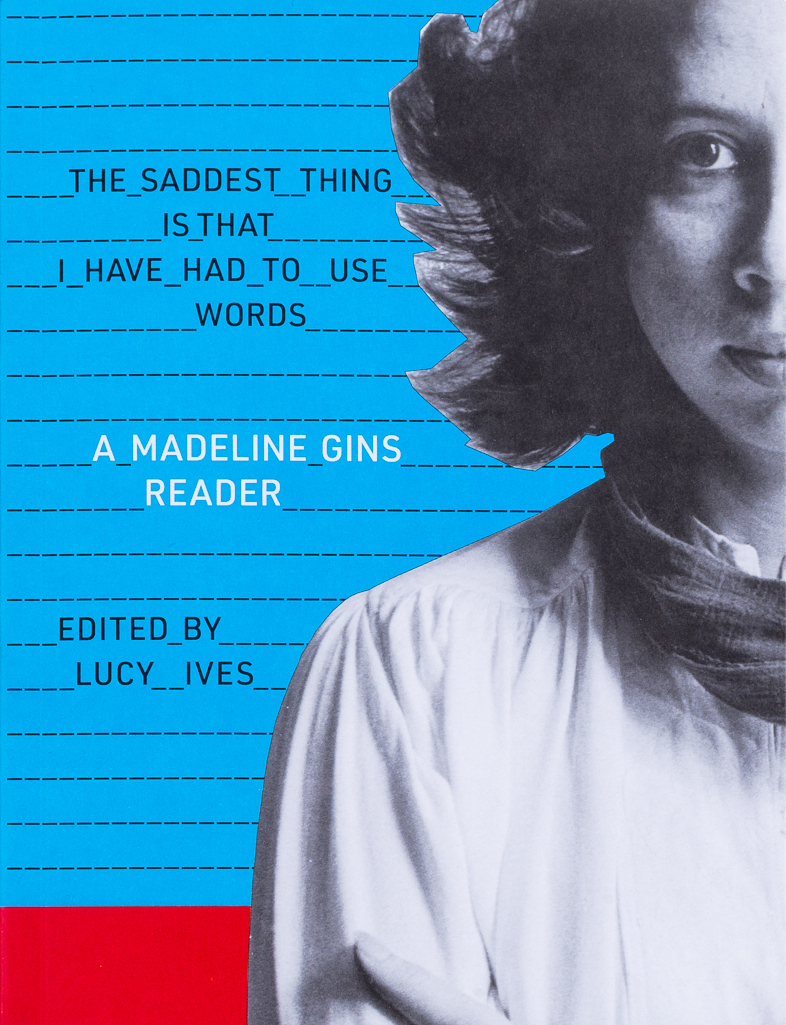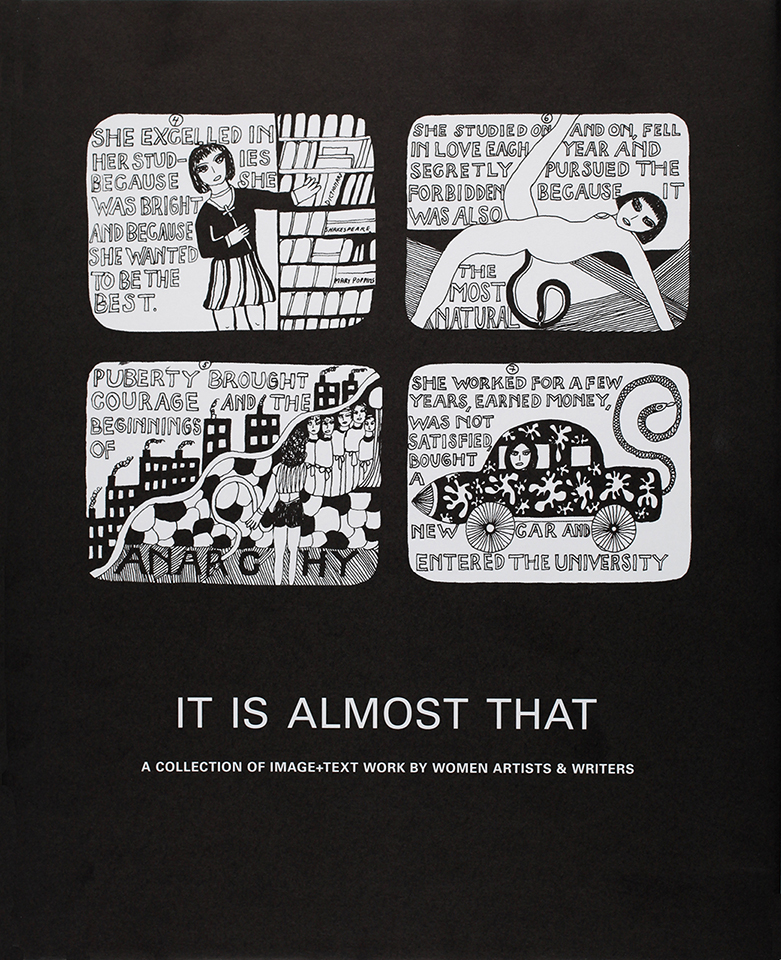Questioning the Very Form of the BookMadeline Gins uses the form to dislodge our notion of individual subjectivity, the narrator commonly known as “I.”Karla Kelsey, Hyperallergic
reviews, 05/09/20
Over the course of five decades, poet, novelist, artist, philosopher, and speculative architect Madeline Gins (1941–2014) developed a groundbreaking body of work that traverses disciplinary boundaries. She is best known for her collaborations with her husband, the artist Shūsaku Arakawa (1936–2010). Arakawa was already a young artist of note when they met in 1962. Collaboration quickly took flight as they expanded his painting practice into a series of 83 image-text panels, collectively titled The Mechanism of Meaning, constructed over the course of a decade. In addition to their art practices, Gins and Arakawa co-authored five books. Most notably, during their 45-year collaboration, they developed the Reversible Destiny architectural project, the goal of which was nothing less than to produce buildings and environments that have the capacity to defeat death. The theory behind this is delightfully complex yet, as their 2002 book Architectural Body outlines, it stems from the very sensible observation that architecture exists primarily in the service of the body. But what is the body in the first place? In speculating on this question much upending of ingrained assumptions ensues: Gins and Arakawa reframe not only the conceptual foundations of architecture, but also of the human, which they propose doesn’t exist apart from the body and environment; more properly, the human is an organism-person-environment (Architectural Body, 1). Five projects were realized and the Reversible Destiny Foundation, created by Gins and Arakawa in 2010 to promote their work, keeps this legacy alive.
Given these factors it is no wonder that the Reversible Destiny project and collaborations with Arakawa have overshadowed Gins’s independent literary production, much of which was unpublished or went out of print in her own lifetime. Who doesn’t want to learn how not to die? Who isn’t instantly charmed by the image of Arakawa and Gins, dated 2007, on the Foundation page of the Reversible Destiny website; they sit on the stoop of their residence and studio at 124 West Houston — she looking like a bohemian sphinx, he holding her hands tight with one hand, the other hand carelessly dangling the keys to what I imagine as a kingdom of creative and domestic bliss. That architecture against death and the romance of collaboration far overshadow Gins’s literary legacy should not lead us to assume that her independent writing is of lesser value than her collaborative work. The error of this assumption is made clear by Siglio Press’s publication of The Saddest Thing Is That I Have Had to Use Words: A Madeline Gins Reader, expertly introduced and edited by Lucy Ives.
Sigilo’s Reader provides access to Gins’s major texts, all of which would be currently unavailable otherwise. Lucky for readers, Ives selects a comprehensive array of works: from the 1960s and ’70s, 27 pages of unpublished poems as well as two essays; a complete facsimile reproduction of Gins’s 1969 experimental novel WORD RAIN; and selections from her two other notable book-length works, What the President Will Say and Do!! (1984) and Helen Keller or Arakawa (1994). Ives terms WORD RAIN a “carefully calibrated and constructed artist’s book, as well as a comment on the novel form,” and asserts that it is “Gins’s most brilliant endeavor and among the most significant works of experimental prose of the second half of the twentieth century.” This is not a hyperbolic assessment — the Reader ought to provoke a revision not only of Gins’s legacy as Arakawa’s collaborator, but of the wherefores and why’s of experimental writing — of its capacity to say and do what other forms of writing or art-making cannot. The book as a form of technology might not defeat death but it can create a space for re-tooling our sense of what it is to be human.
This is a tall order, but Gins’s inquiry gains its power from an approach similar to that of her architectural theory: the book, like the building, provides the opportunity to question habitual concepts of being human, re-designing technology to better cultivate human assets. Given the irrevocable preoccupation with the individual that accompanies books (we might read the same book but I cradle my own singular copy, feel language move through me as I transform marks on a page into “sense”) it isn’t surprising that Gins uses the form to dislodge conventions surrounding the literary vehicle for individual subjectivity par excellence — the narrator commonly known as “I.”
This retooling manifests throughout A Reader in different ways: a chapter of What the President Will Say and Do! titled “Brief Autobiography of a Non-Existent,” for example, plays with chronology, offering an “autobiographical” dateline that begins in 1913, proceeds up to 1932, dips back to 1840, and jogs back through the ’30s while bouncing to the ‘20s and including the dates of 1300 and 1 along the way . All of the “events” in this “autobiography” are written as negations: “1915: A bee did not sting me and cause a high fever which produced strange deliriums from which I still suffer. 1918: I did not begin to masturbate. I had no intention of playing hookey.” Disordering the temporal frame and writing facts as negations points up the absurdity of depending on timelines to convey a life; it suggests that the self might be fruitfully considered from the point of view of what it is not. Hellen Keller or Arakawa’s narrator proposes a sort of hybrid identity that is sometimes Arakawa, sometimes Keller, sometimes Gins — and sometimes a combination of all three, passing through, as Gins notes in her “Sources” page, “the words and images of Helen Keller and Arakawa and others.” These “others” include poets (like Paul Celan, Robert Creeley, and Stacy Doris) as well as philosophers (like Gershom Scholem) and thinkers from other disciplines.
In WORD RAIN, the novel’s unidentified narrator is not the creator of the tale that we are reading but is, rather, a reader who involves us in the process of reading a manuscript. This undermines the standard alignment of first-person narrators with authorship of their own stories, and their desire to distinguish “I” from not-I. How does being human look, WORD RAIN asks, if we consider the “I” as a reader rather than author?
For one, the act of reading, as articulated by Gins, is inventive, active, manifold. She presents her reader-narrator not only discovering the manuscript’s plot, but also engaged in such activities as skimming, reading out loud, and reading creatively, breaking passages down and inventively defining words. The reader-narrator often turns to their reader — to us — to provide instruction: “Read this aloud with your voice trailing your eyes: I am reading this aloud.” This extends the play of participation from the reader-narrator and her text to the person who holds the book.
Continue reading at Hyperallergic
see also
✼ the improbable:
from Issue, No. 1 (Time Indefinite), “Dick Higgins, Publisher: Notes Toward a Reassessment of the Something Else Press Within a Small Press History” by Matvei Yankelevich: “To find connections between poetry, small press publishing, and the art scene of the early 1960s, one may look no further than Higgins’ own network.”
[...]
